Other Animals
Besides reptiles, herbivorous and big cats, Machia Biological Park has various other animals including jungle cat, desert cat, striped hyena, sloth bear, hedge hog etc.
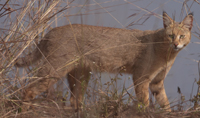 Jungle Cat:: Like domestic cat, Jungle cats are very hard to tame even if taken into captivity at a young age. They can easily climb the trees like most of the cat. They always use their excellant sight and hearing capacity alongwith a strong sense of smell during hunting. Jungle cat can travel upto six kms or more in one night in search of prey. They mark their territories by spraying urine and can leap to catch the bird in the flight.
Jungle Cat:: Like domestic cat, Jungle cats are very hard to tame even if taken into captivity at a young age. They can easily climb the trees like most of the cat. They always use their excellant sight and hearing capacity alongwith a strong sense of smell during hunting. Jungle cat can travel upto six kms or more in one night in search of prey. They mark their territories by spraying urine and can leap to catch the bird in the flight.
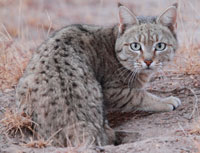 Desert Cat::
Desert Cat:: Desert cat has a short tail in comparison to its body. Females are somewhat lighter in colour than the males. Ears are small and pointed with faint black tufts. The head is broader then that of the domestic cat. Nose pad is pink in colour. The cat is found in drier parts of Punjab,Gujarat,Rajasthan and Maharashtra.
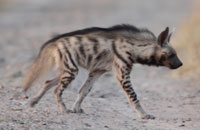 Striped Hyena::
Striped Hyena:: The striped hyena is an ungainly animal with a sloping back. It is largely dirty greyish-brown with black stripes on its sides and legs. It is primarily a scavenger amd feeds on leftovers of other predators. The hyena is a monogamous animal, with both males and females assisting one another in raising their cubs.
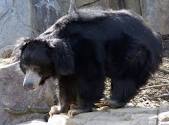 Sloth Bear::
Sloth Bear:: It is a sloth bear. Take a closer look. Its snout protrudes like a little trunk. The lower lip is long. The tongue, if you get to see it, it is slender. There is a gap in its front teeth, as it lacks the pair of teeth called incisors. This gives bear the excellent sucking ability. The sloth bear active as soon as it comes accross a termite mound/house. It first blows the dust away and then tears apart the termite mound with its long, curved , claws. The force with which it sucks its food, white ants, is so tremendous that the sucking noise can be heard even 200 meters away. It also feeds on fruits and insects.
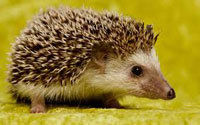 Hedgehog::
Hedgehog:: Hedgehog are easily recognized by their spines, which are hollow hairs made stiff with keratin. Hedgehog posses the ability to roll into a tight ball, causing all the spines to paint outwards. They are generally nocturnal. Hedgehog are not exclusively insectivorous but are omnivorous. They feed on insects,snails,frogs and toads.Gestation period of this animal is 35-58 days and average litter size is 3-4.
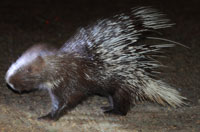 Porcupine::
Porcupine:: Porcupine is a large rodent, covered with black and white quills. It has a crest of spines on its forehead. It is found in different habitats. Its tail is covered with short hollow quills that can rattle when threatened. It has broad feet and long claws for digging. It is nocturnal and creates underground shelters. It eats variety of plants including their fruits and roots.
 Jackal::
Jackal:: The Jackal largely depends on kills made by bigger animals. As soon as lion, a tiger or a leopard withdraws from its kill, the jackal comes on the scene to commence its feast. Scavenging is a part of the jackal's life. Occassionally though it does hurt hares, birds, lizards, turtles and various insects. By no means is the jackal a coward species, as many people believe. It scouts the land for carrion and fights off its competitors like vulture, eagles and even hyenas.
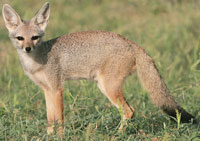 Common Fox::
Common Fox:: Indian fox is also known as Bengal fox. This fox is endemic to Indian subcontinent. This has an elongated muzzle, long, pointed ears and a bushy tail. Tail has a prominent black tip which distinguishes it from other foxes. The preffered habitat is short open grasslands,scrub or thorn forest.
 Desert Fox::
Desert Fox:: Desert fox is a small nocturnal fox. Its most distinctive feature is its unusually large ears, which also serve to dissipate heat. Its coat, ears, and kidney functions have adapted to high-temperature, low-water, desert environments. In addition, its hearing is sensitive enough to hear prey moving underground. It mainly eats insects, small mammals, and birds.
 Indian Wolf::
Indian Wolf:: Indian Wolf is a grey species which is generally smaller than European wolves. Its colour is mostly grey with black tipped tail. Indian wolves have a nuclear family of six to eight animals. Indian wolves typically prey on ungulates, rodents and hares but they also prey on domestic goat and cattle bringing them into conflict with human. The population of wolves in India is estimated to be around 3000 and decreasing mainly due to loss of habitat and prey base decline.